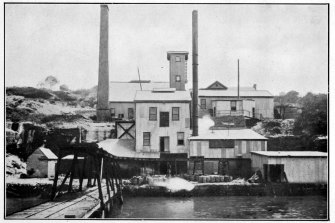In its revised plan for the operation, published by the Planning Department, the company said Veolia had committed to store the material at its Port Botany transfer facility following months of negotiations.
However, it said the company’s landlord had an “extremely negative” reaction towards the plan and threatened legal action should the project proceed without their consent.

The Radium Hill Company uranium refinery at Hunters Hill, which operated during the early 20th century.Credit:Photographer unkown
“While it is possible for Veolia to proceed without the landlord’s approval, the risk to future goodwill in
dealing with the landlord as well as extreme financial risk to the project overall has made this unlikely,” US Ecology said in its report.
The company said it intended to transport the material via Adelaide, where logistics company Alara had a facility that was licensed to store such waste.
“While the extended trucking from Sydney increases cost and risk slightly, these are more than mitigated by the gained cost control of the Alara owned storage facility, the flexibility in vessel booking and loading at the Adelaide port, and the overall use of a safe and established routing that has been well established over the years for like material,” US Ecology said.
Neither the NSW Environment Protection Authority (EPA) or Hunters Hill Council objected to the revised plan, which was approved on December 24.
A Veolia spokeswoman said the company was “pleased an alternate resolution has been identified”.
The plan said US Ecology would remove 1712 tonnes of soil that authorities considered to be non-hazardous. The material had radiological contamination and contained uranium, radium, thorium and lead.
The EPA classified the land as “restricted solid waste”.
Loading
A Department of Planning spokeswoman said work to remove the contaminated soil began in September and is expected to take 18 to 24 months.
“[The Australian Nuclear Science and Technology Organisation] will be responsible for establishing controlled zones and decontamination procedures throughout the remediation process. There will also be stringent controls regarding dust and noise,” she said.
The spokeswoman said the material would be transported according to state and federal guidelines. The project would make the land suitable for residential use.
“This remediation solution will deliver the best outcomes for residents and taxpayers, putting an end to a century-old contamination issue,” she said.
The Morning Edition newsletter is our guide to the day’s most important and interesting stories, analysis and insights. Sign up here.


